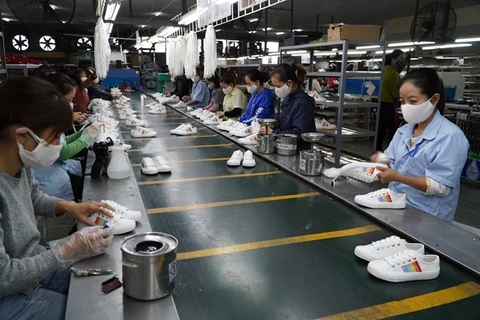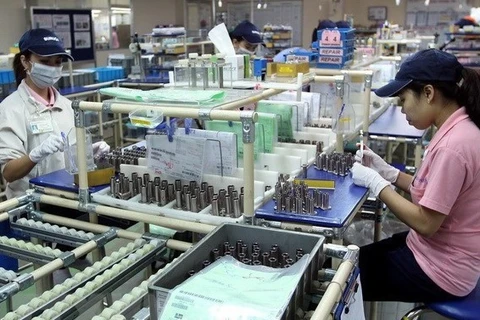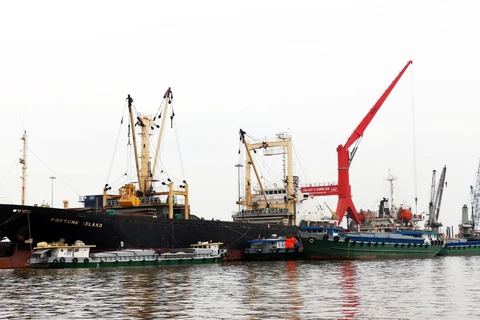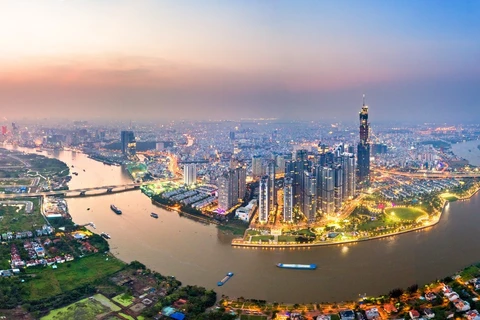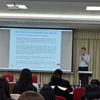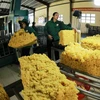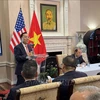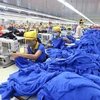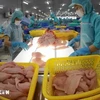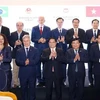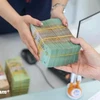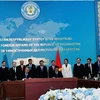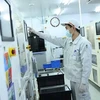Hanoi (VNA) - Despite impacts caused by the COVID-19 pandemic, foreign direct investment (FDI) is still being poured into Vietnam, contributing importantly to turning the country into a new production hub of the world.
Registered capital, disbursement boom
Over the past five years, since Vietnam reviewed its 30-year foreign investment attraction, the FDI flow into the nation has not ceased increasing.
Statistics from the Ministry of Planning and Investment (MPI) show that from January 2018 to April 20, 2023, the registered FDI in Vietnam totaled 180 billion USD, equaling 40.3% of the accumulated investment capital over the last 35 years.
As of April 2023, Vietnam had attracted 37,065 foreign-invested projects with a total registered capital of 445.87 billion USD, with 279.8 billion USD of the total being disbursed.
HSBC, in its report on attracting foreign investment in ASEAN in the middle of last year, highlighted a boom in foreign investment into ASEAN, saying that Vietnam and ASEAN are the two markets receiving the most of foreign investment capital.
Over the last five years, the total FDI disbursement hit 107.47 billion USD, equaling 38.4% of the total disbursed capital over the past 35 years. About 19-20 billion USD of FDI is averagely disbursed every year during the reviewed period. A record of FDI disbursement was set in 2022 with 22.4 billion USD.
The quality of foreign investment into Vietnam has also improved significantly.
Becoming new production centre
According to Minister of Planning and Investment Nguyen Chi Dung, more and more multinationals and big investors have continuously invested in Vietnam.
 More and more multinationals and big investors have continuously invested in Vietnam. - Illustrative image (Photo: VNA) Economists said that the foreign-invested economic sector has made an important contribution to the added value of industrial products thanks to international economic groups' investment in many large-scale projects which use high technology, and modern services.
More and more multinationals and big investors have continuously invested in Vietnam. - Illustrative image (Photo: VNA) Economists said that the foreign-invested economic sector has made an important contribution to the added value of industrial products thanks to international economic groups' investment in many large-scale projects which use high technology, and modern services.
Dozens of research and development (R&D) centres, innovation hubs, and technology incubators have been established, making it easier for domestic firms, especially small- and medium-sized enterprises, to connect with foreign businesses, they noted.
When it comes to success economic stories driven by foreign investment, Vietnam is a prominent example, HSBC said, highlighting that Vietnam turned itself into a rising star in global supply chains, gaining substantial global market share in such sectors as textiles, footwear and consumer electronics.
The bank also mentioned large-scale investments of Samsung, Pegatron, Foxconn, Luxshare, and Goertek, stressing that Vietnam is transforming itself into the world's technology factory.
Not long ago, Quanta Computer of Taiwan (China) signed an agreement with the People's Committee of the northern province of Nam Dinh on developing a large-scale computer production project in My Thuan Industrial Park, which is expected to have an investment capital of 120 million USD. This is Quanta's 9th factory globally and the first in Vietnam.
Quanta is a MacBook manufacturing partner of Apple, so the appearance of this corporation in Vietnam means that Apple is continuing to shift its production to the Southeast Asian nation.
Foxconn, another partner of Apple, is also planning to set up a new factory in the central province of Nghe An, to expand its production in Vietnam after it successfully invested in the northern provinces of Bac Ninh and Bac Giang.
Samsung is a good example of the foreign investment scale in Vietnam. So far, the group’s total investment in the country has hit 20 billion USD.
Meanwhile, LG’s investment in Vietnam totaled 7.5 billion USD in the last five years. The group has continuously added capital to its factories - LG Display, LG Innotek, and LG Electronics.
Foxconn, Pegatron, Winston, Goertek, and Amkor have continuously increased their investment capital in Vietnam, including billions-USD commitments.
According to Christopher J Marriott, CEO of Savills Southeast Asia, Vietnam is considered one of the prominent destinations for high-value industries with production capacity that meets the expectation of international investors and technology corporations.
Last year also marked another important turning point when Lego Group of Denmark officially started construction of a project worth over 1.3 billion USD in Vietnam. Given that Vietnam has committed to cutting emissions to net zero by 2050, Lego's first global carbon-neutral project is seen as a start of green investment in the Southeast Asian nation./.
Registered capital, disbursement boom
Over the past five years, since Vietnam reviewed its 30-year foreign investment attraction, the FDI flow into the nation has not ceased increasing.
Statistics from the Ministry of Planning and Investment (MPI) show that from January 2018 to April 20, 2023, the registered FDI in Vietnam totaled 180 billion USD, equaling 40.3% of the accumulated investment capital over the last 35 years.
As of April 2023, Vietnam had attracted 37,065 foreign-invested projects with a total registered capital of 445.87 billion USD, with 279.8 billion USD of the total being disbursed.
HSBC, in its report on attracting foreign investment in ASEAN in the middle of last year, highlighted a boom in foreign investment into ASEAN, saying that Vietnam and ASEAN are the two markets receiving the most of foreign investment capital.
Over the last five years, the total FDI disbursement hit 107.47 billion USD, equaling 38.4% of the total disbursed capital over the past 35 years. About 19-20 billion USD of FDI is averagely disbursed every year during the reviewed period. A record of FDI disbursement was set in 2022 with 22.4 billion USD.
The quality of foreign investment into Vietnam has also improved significantly.
Becoming new production centre
According to Minister of Planning and Investment Nguyen Chi Dung, more and more multinationals and big investors have continuously invested in Vietnam.
 More and more multinationals and big investors have continuously invested in Vietnam. - Illustrative image (Photo: VNA)
More and more multinationals and big investors have continuously invested in Vietnam. - Illustrative image (Photo: VNA) Dozens of research and development (R&D) centres, innovation hubs, and technology incubators have been established, making it easier for domestic firms, especially small- and medium-sized enterprises, to connect with foreign businesses, they noted.
When it comes to success economic stories driven by foreign investment, Vietnam is a prominent example, HSBC said, highlighting that Vietnam turned itself into a rising star in global supply chains, gaining substantial global market share in such sectors as textiles, footwear and consumer electronics.
The bank also mentioned large-scale investments of Samsung, Pegatron, Foxconn, Luxshare, and Goertek, stressing that Vietnam is transforming itself into the world's technology factory.
Not long ago, Quanta Computer of Taiwan (China) signed an agreement with the People's Committee of the northern province of Nam Dinh on developing a large-scale computer production project in My Thuan Industrial Park, which is expected to have an investment capital of 120 million USD. This is Quanta's 9th factory globally and the first in Vietnam.
Quanta is a MacBook manufacturing partner of Apple, so the appearance of this corporation in Vietnam means that Apple is continuing to shift its production to the Southeast Asian nation.
Foxconn, another partner of Apple, is also planning to set up a new factory in the central province of Nghe An, to expand its production in Vietnam after it successfully invested in the northern provinces of Bac Ninh and Bac Giang.
Samsung is a good example of the foreign investment scale in Vietnam. So far, the group’s total investment in the country has hit 20 billion USD.
Meanwhile, LG’s investment in Vietnam totaled 7.5 billion USD in the last five years. The group has continuously added capital to its factories - LG Display, LG Innotek, and LG Electronics.
Foxconn, Pegatron, Winston, Goertek, and Amkor have continuously increased their investment capital in Vietnam, including billions-USD commitments.
According to Christopher J Marriott, CEO of Savills Southeast Asia, Vietnam is considered one of the prominent destinations for high-value industries with production capacity that meets the expectation of international investors and technology corporations.
Last year also marked another important turning point when Lego Group of Denmark officially started construction of a project worth over 1.3 billion USD in Vietnam. Given that Vietnam has committed to cutting emissions to net zero by 2050, Lego's first global carbon-neutral project is seen as a start of green investment in the Southeast Asian nation./.
VNA

